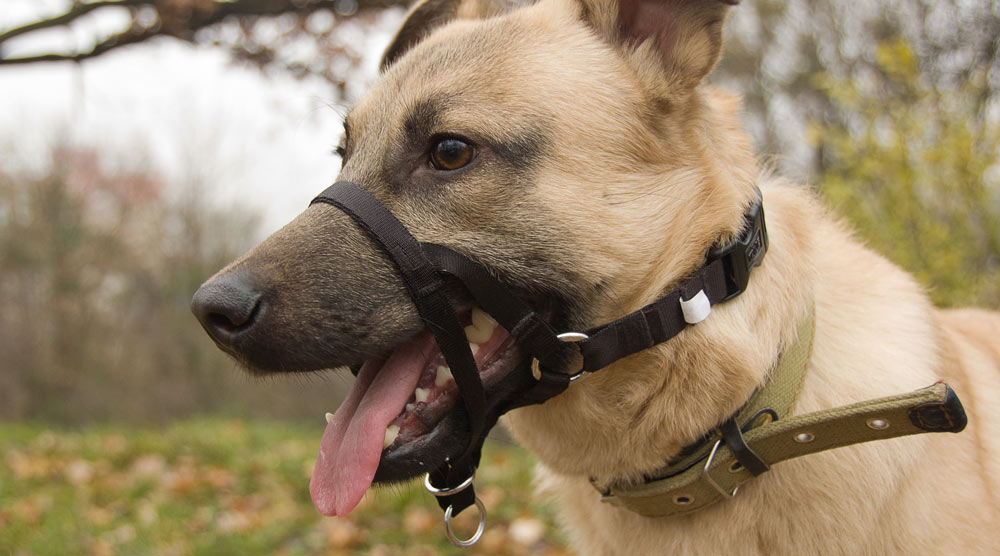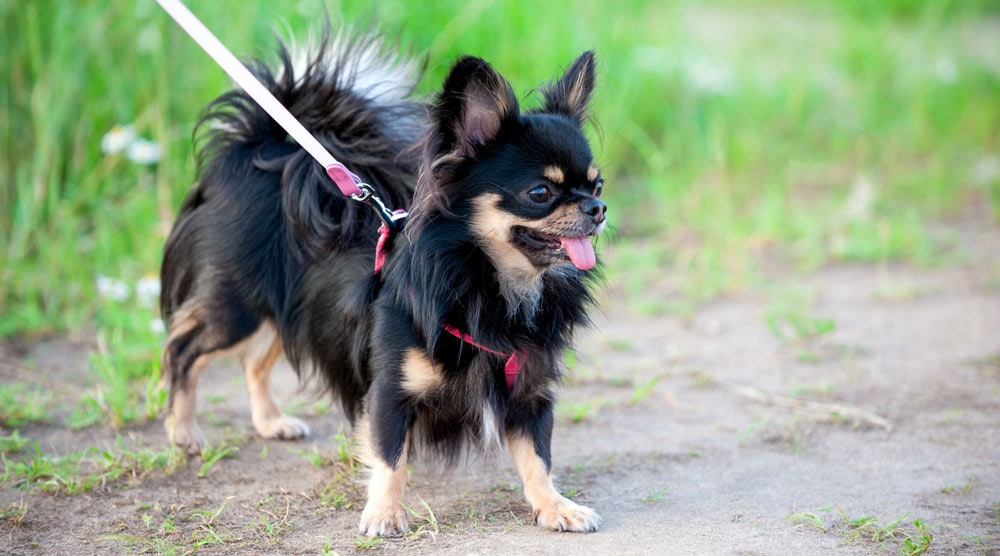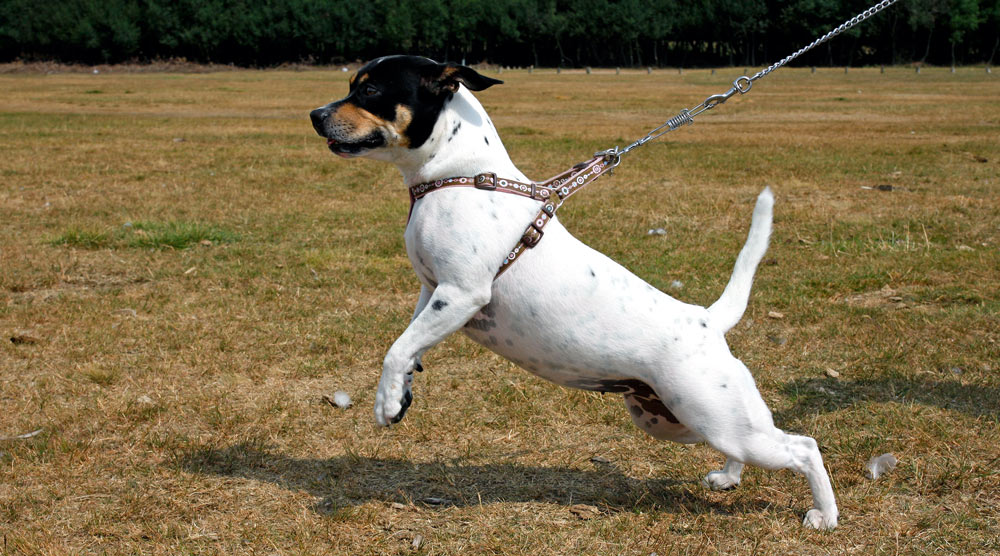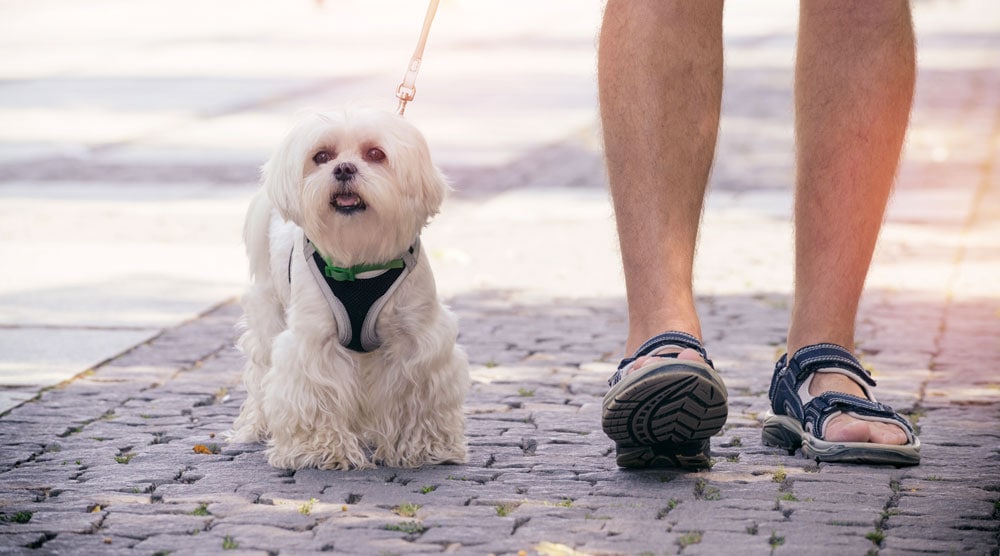Key Takeaways
- Head halters reduce pulling by turning the dog’s nose away from where they want to go. However, they direct all the pulling force onto the dog’s delicate snout and nose, which causes discomfort and even pain.
- Head halters can cause serious injury to the neck if the dog lunges or the leash is jerked. They also don’t teach the dog to loose leash walk.
- For these reasons, we don’t recommend using head halters on most dogs – even if they pull.
- We only recommend head halters as a temporary tool for strong dogs that may injure the owner when pulling or lunging.
- Even for these dogs, halters should only be used with the assistance of a canine behaviorist. The goal should be to resolve the underlying problem and teach loose leash walking, so that the halter isn’t required in the long run.
While head halters for dogs can provide more control if your pet is a strong puller, we don’t recommend them in the majority of cases. Despite the manufacturers’ claims, halters are an aversive training tool that cause discomfort to the dog and don’t solve the underlying problem.
These collars work by directing pulling force through the nose, causing the dog to be turned where the owner wants to go. They only work because the dog is uncomfortable or even in pain when pulling. Halters can also cause injuries if the dog pulls too hard or lunges.
For these reasons, we only recommend a head halter if your dog is very strong and there is a risk that they will pull you over. However, the halter should still be a temporary measure while you teach them loose lead walking, or while you work with a qualified behaviorist to resolve fear and reactivity.
Contents
How Does a Head Halter Work?
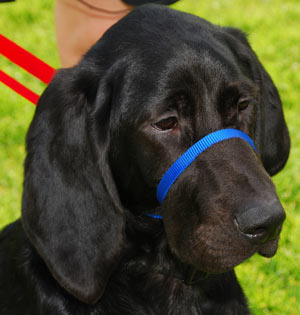
Head halters are often mistaken for a muzzle, but are designed for a very different purpose.
This type of harness usually has a strap around the dog’s nose and muzzle, with another that attaches around the back of the dog’s neck. Unlike regular harnesses or collars, head halters have a leash attachment point below the chin.
When the dog pulls forward, the leash attachment pulls the nose down and towards the owner. This makes it difficult for a dog to pull in a straight line, but also allows you to control your pet’s direction.
Why Halters Aren’t Really a “No Pain” Training Tool
Head halters, such as the Halti or Gentle Leader, are often praised as a “no pain” alternative to spike or choke chains.
However, they essentially redirect the entire pulling force of the dog onto the delicate snout and nose area, which is (at best) very uncomfortable. In some situations, this type of collar could even be dangerous, especially if the dog suddenly jerks the leash.
This is why we believe head halters should only be used as a last resort and as a temporary measure. It’s also important to use them with the help of an accredited canine behaviorist, as a halter could increase your dog’s anxiety or reactivity if it isn’t properly introduced.
It’s also important to realize that halters don’t solve a pulling dog problem. While a head halter might reduce pulling temporarily, it doesn’t train a dog not to do it when you return to a regular harness or collar.

Head Halters: A Dog Trainer’s Perspective
“I almost never suggest a head halter to my clients. The exception is if there is a safety concern and the owner is unable to hold their dog back when pulling. In this situation, a halter can be a useful temporary tool.”
“These safety concerns aren’t always because the dog is reactive or aggressive though. For example, I recently worked with a Labrador who pulled to follow a scent (which is totally natural!) However, his human mum had just had a baby and was struggling to keep control on walks.”
“We took a week off walks to introduce him to the head halter using positive reinforcement at home. Of course, we made sure to meet his exercise needs with games in the garden.”
“After the desensitization process, his owner started walking him to the park on the halter, but let him off lead once it was safe to do so. We are now working on loose lead walking with a harness, and will gradually stop using the halter once he has mastered it!” – Rebecca Morello, IMDT Dog Trainer
Who Should Use a Head Halter?
At The Dog Clinic, we only support pain-free and non-aversive training methods. For this reason, we don’t think head halters should be used in most situations.
While they aren’t as bad as choke chains or prong collars, head halters still rely on discomfort or pain to prevent a behavior. They can also increase reactivity, especially if the dog feels restricted or hasn’t been desensitized to wearing the halter.
For these reasons, we only recommend head halters as a temporary tool when there is a danger a strong dog could cause injury when pulling or lunging. We also recommend that head halters are only used with the help of a qualified canine behaviorist.
Tips for Safely Using a Head Halter
If you decide to use a head halter, you should always read the instructions carefully. Every halter is slightly different, so it’s vital to understand the product and how to use it safely.
Be aware that head halters can be dangerous in some situations. For example:
- If your dog lunges, a halter can cause serious damage to the neck.
- Similarly, jerking the leash can risk a serious injury to the dog’s neck.
- If the halter is the wrong size, it may cause uncomfortable chafing.
- It can be difficult to use halters on dogs with short snouts, as the strap often falls off.
Here are some tips for keeping your dog safe when wearing a head halter.
Protect Your Dog’s Neck
The most important rule is you should never jerk your dog’s head when wearing a head halter. This can cause serious injury to the dog’s neck. When using the halter to change direction, use light pressure and relieve the tension as soon as the dog reacts correctly.
Similarly, you shouldn’t use a head halter with an extendable leash. If your dog runs to the end of the line and has their head jerked back, the sudden movement can cause a neck strain.
Use Positive Reinforcement
You shouldn’t expect your pet to accept a head halter immediately. In fact, halters can cause stress and increased reactivity if the dog isn’t properly desensitized to wearing one.
The best way to prevent this is by gradually introducing the collar using positive reinforcement.
Start by allowing your dog to sniff the collar, then give praise and a treat. Work towards putting on the collar for a short time; then, once your dog accepts this, you can practice wearing it in the garden. Only when your pet is comfortable wearing the collar should you start using it on walks.
Be patient when teaching your pet to use a head halter. It may take time for your dog to become desensitized to it, but rushing this step can cause them to become scared of the collar.
Use a Dual-Ended Leash
Halters use discomfort to discourage pulling, so it’s important to only place tension through them when it’s absolutely necessary.
To avoid unnecessary discomfort, purchase a double-ended leash, then attach one end to the dog’s harness and the other to the halter. This allows you to put most of the pressure through the harness and only use the halter if needed.
Choose a High-Quality Head Halter
Not all head halters are made the same. Some are little more than a flimsy strap across the muzzle, which tends to ride up into the dog’s eyes!
Instead, look for a head halter with soft padding and a design that prevents the strap from riding up. The halter should also be easy to adjust to your dog’s unique shape.
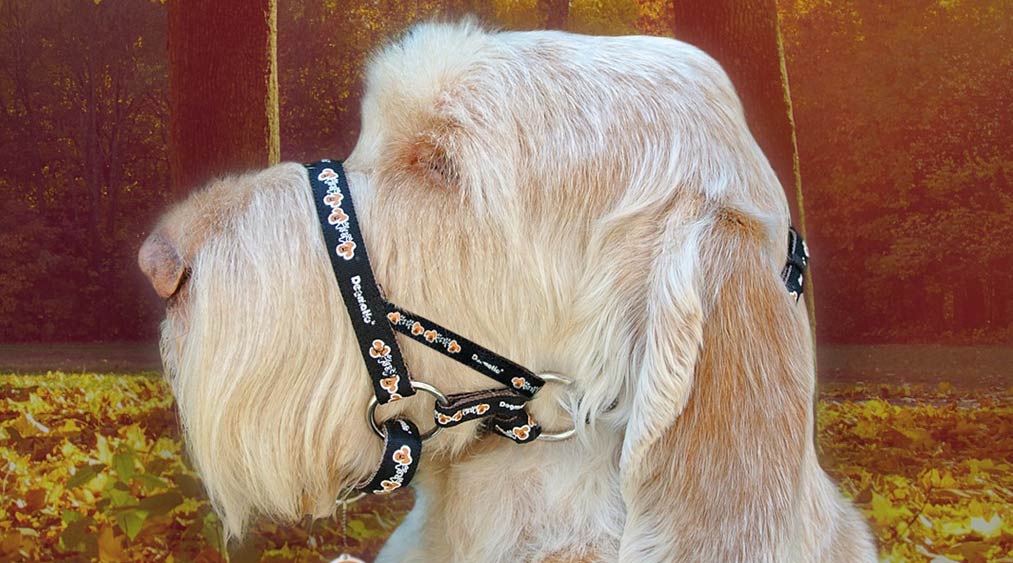
Make Sure the Halter is Fitted Correctly
A poorly fitted head halter isn’t just less effective. It’s also much more likely to cause injury to the neck.
It’s vital the collar isn’t too tight. If the dog can’t gain relief by walking on a loose lead, there isn’t any incentive to avoid pulling – and the walk will be very uncomfortable for them. Instead, try to fit the halter so the dog can open their mouth normally, but without the strap slipping off.
You should always follow the manufacturer’s guidelines for fitting a halter, but here are a few tips for getting a good fit:
- You should be able to fit 1-2 fingers between the neck strap and your dog’s skin.
- Ensure the neck strap is high on your dog’s neck (i.e., close to the ears).
- The D-Ring leash attachment should be beneath the chin.
On a side note, your dog should only ever wear a halter when you can supervise them. Never leave a dog unattended wearing one of these collars.
Summary
Head halters might be marketed as a “no pain” solution to pulling, but they are actually an aversive training tool. Halters reduce pulling by causing discomfort or even pain to the dog’s snout and face, which is why we don’t recommend them for most dogs.
The exception is a strong dog who is at risk of causing injury to their owner when pulling or lunging. In this situation, a head halter can be a useful temporary fix, as long as the halter is introduced positively and with the help of a canine behaviorist.
We hope this article has helped you understand head halters for dogs and why we don’t recommend them for most situations. If you have any questions, please let us know in the comments section. You may also want to read our guide to types of dog harnesses.
